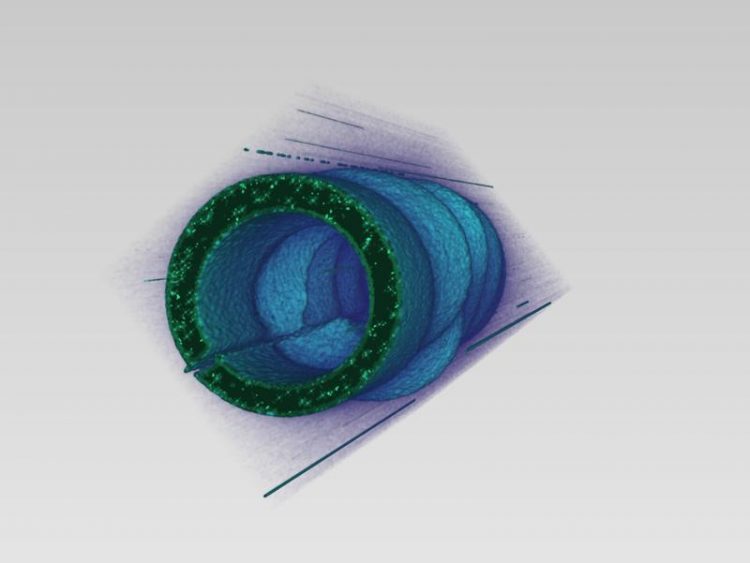Mapping electromagnetic waveforms

A three-dimensional depiction of the spatial variation of the optical electromagnetic field around a microantenna following excitation with terahertz pulse. The optical field is mapped with the aid of electron pulses. Graphic: Dr. Peter Baum
Temporally varying electromagnetic fields are the driving force behind the whole of electronics. Their polarities can change at mind-bogglingly fast rates, and it is difficult to capture them in action. However, a better understanding of the dynamics of field variation in electronic components, such as transistors, is indispensable for future advances in electronics.
Researchers in the Laboratory for Attosecond Physics (LAP), jointly run by Ludwig-Maximilians-Universität (LMU) and the Max Planck Institute of Quantum Optics (MPQ), have now taken an important step towards this goal – by building an electron microscope that can image high-frequency electromagnetic fields and trace their ultrafast dynamics.
The electronic devices we have become so familiar with and use every day are – without exception – powered by changing electromagnetic fields. These fields control the flow of electrons in components such as ‘field-effect’ transistors, and are ultimately responsible for the manipulation, flow and storage of data in our computers and smartphones.
A better understanding of electromagnetic waveforms and their ultrafast reconfiguration in individual components will help to shape the future of electronics. The LMU and MPQ physicists who belong to the research group in Ultrafast Electron Imaging have now developed an electron microscope that is specifically designed for the analysis of rapidly varying electromagnetic fields.
This instrument makes use of ultrashort pulses of laser light, each of which lasts for a few femtoseconds (a femtosecond equals one millionth of a billionth (10 to the minus 15) of a second). These laser pulses are used to generate bunches of electrons made up of very few particles, which are then temporally compressed by the action of terahertz (10 to the 12 Hz) near-infrared radiation. The Munich team first described this strategy earlier this year in the journal Science (Science 22. April 2016, doi: 10.1126/science.aae0003), and demonstrated that it can generate electron pulses that are shorter than a half-cycle of the optical field.
The researchers now show that these ultrashort electron pulses can be used to map high-frequency electromagnetic fields. In the experiment, the pulses are directed onto a microantenna that has just interacted with a precisely timed burst of terahertz radiation. The light pulse excites surface electrons in the antenna, thus creating an oscillating optical (electromagnetic) field in the immediate vicinity (the so-called near field) of the target.
When the electron pulses come under the influence of the induced electromagnetic field around the antenna, they are scattered, and the pattern of their deflection is recorded. On the basis of the dispersion of the deflected electrons, the researchers can reconstruct the spatial distribution, temporal variation, orientation and polarization of the light emitted by the microantenna.
“In order to visualize electromagnetic fields oscillating at optical frequencies, two important conditions must be met“, explains Dr. Peter Baum, who led the team and supervised the experiments. “The duration of each electron pulse, and the time it takes to pass through through the region of interest, must both be less than a single oscillation period of the light field.” The electron pulses used in the experiment propagate at speeds approximately equal to half the speed of light.
With their novel extension of the principle of the electron microscope, the Munich physicists have shown that it should be feasible to precisely detect and measure even the tiniest and most rapidly oscillating electromagnetic fields. This will allow researchers to obtain a detailed understanding of how transistors or optoelectronic switches operate at the microscopic level.
The new technology is also of interest for the development and analysis of so-called metamaterials. Metamaterials are synthetic, patterned nanostructures, whose permeability and permittivity for electrical and magnetic fields, respectively, deviate fundamentally from those of materials found in nature. This in turn gives rise to novel optical phenomena which cannot be realized in conventional materials. Metamaterials therefore open up entirely new perspectives in optics and optoelectronics, and could provide the basic building blocks for the fabrication of components for light-driven circuits and computers. The new approach to the characterization of electromagnetic waveforms based on the use of attosecond physics brings us a step closer to the electronics of the future. Thorsten Naeser
Original publication:
A. Ryabov and P. Baum
Electron microscopy of electromagnetic waveforms
Science, 22. Juli 2016, Vol. 353 Issue 6297; doi: 10.1126/science.aaf8589
Contact:
Dr. Peter Baum
Ludwig-Maximilians-Universität Munich
Am Coulombwall 1
85748 Garching, Germany
Phone: +49 (0)89 / 289 -14102
E-mail: peter.baum@lmu.de
www.ultrafast-electron-imaging.de
Dr. Olivia Meyer-Streng
Press & Public Relations
Max Planck Institute of Quantum Optics
Phone: +49 (0)89 32 905 -213
E-mail: olivia.meyer-streng@mpq.mpg.de
Media Contact
All latest news from the category: Physics and Astronomy
This area deals with the fundamental laws and building blocks of nature and how they interact, the properties and the behavior of matter, and research into space and time and their structures.
innovations-report provides in-depth reports and articles on subjects such as astrophysics, laser technologies, nuclear, quantum, particle and solid-state physics, nanotechnologies, planetary research and findings (Mars, Venus) and developments related to the Hubble Telescope.
Newest articles

A ‘language’ for ML models to predict nanopore properties
A large number of 2D materials like graphene can have nanopores – small holes formed by missing atoms through which foreign substances can pass. The properties of these nanopores dictate many…

Clinically validated, wearable ultrasound patch
… for continuous blood pressure monitoring. A team of researchers at the University of California San Diego has developed a new and improved wearable ultrasound patch for continuous and noninvasive…

A new puzzle piece for string theory research
Dr. Ksenia Fedosova from the Cluster of Excellence Mathematics Münster, along with an international research team, has proven a conjecture in string theory that physicists had proposed regarding certain equations….



